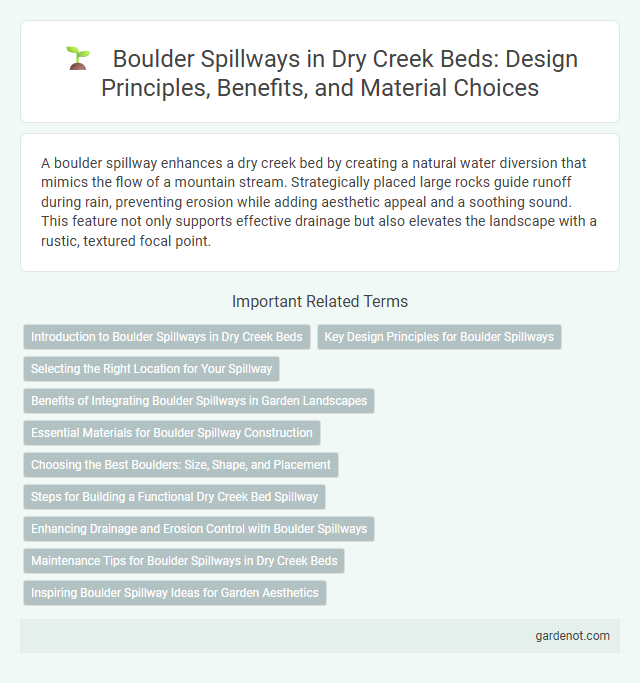A boulder spillway enhances a dry creek bed by creating a natural water diversion that mimics the flow of a mountain stream. Strategically placed large rocks guide runoff during rain, preventing erosion while adding aesthetic appeal and a soothing sound. This feature not only supports effective drainage but also elevates the landscape with a rustic, textured focal point.
Introduction to Boulder Spillways in Dry Creek Beds
Boulder spillways in dry creek beds serve as natural or engineered structures to manage water flow during heavy rains, preventing erosion and directing runoff efficiently. These spillways utilize strategically placed boulders to stabilize the channel, helping to dissipate energy and reduce sediment transport. Properly designed boulder spillways support watershed health by maintaining soil integrity and promoting controlled water passage.
Key Design Principles for Boulder Spillways
Key design principles for boulder spillways include ensuring stable rock placement to withstand hydraulic forces and prevent erosion, optimizing flow paths to manage water velocity and reduce turbulence, and incorporating appropriately sized boulders to balance structural integrity with environmental concerns. The spillway must accommodate peak discharge volumes while maintaining natural aesthetics and supporting aquatic habitat connectivity. Structural alignment with topography and effective energy dissipation zones are essential to sustain long-term functionality and minimize downstream sediment transport.
Selecting the Right Location for Your Spillway
Selecting the right location for your Boulder spillway involves assessing the natural slope and soil stability within the dry creek bed to ensure effective water flow and erosion control. Positioning the spillway where water naturally accumulates minimizes excavation while enhancing sediment transport and reducing downstream flooding. Proper site evaluation includes analyzing watershed size, vegetation cover, and underlying rock formations to optimize spillway performance and longevity.
Benefits of Integrating Boulder Spillways in Garden Landscapes
Boulder spillways enhance garden landscapes by efficiently managing stormwater runoff, preventing soil erosion, and promoting groundwater recharge. Their natural appearance blends seamlessly with dry creek beds, creating visually appealing water features while supporting local biodiversity. Integrating boulder spillways improves landscape durability and reduces maintenance by directing water flow through stable, permeable surfaces.
Essential Materials for Boulder Spillway Construction
Essential materials for Boulder Spillway construction include durable aggregate such as crushed stone and gravel, which provide structural stability and facilitate efficient water flow. High-strength geotextiles are critical for erosion control and soil reinforcement, ensuring long-term durability of the spillway channel. Concrete and steel reinforcements are used in key zones to withstand hydraulic pressures and prevent structural failure during peak flow events.
Choosing the Best Boulders: Size, Shape, and Placement
Selecting the right boulders for a dry creek bed spillway is crucial for effective water flow management and erosion control. Optimal boulder size ranges from 12 to 36 inches in diameter, providing stability and durability against heavy water runoff. Placement should mimic natural stream patterns, with larger, flat-faced boulders positioned at key points to direct flow and smaller stones filling gaps to prevent soil displacement.
Steps for Building a Functional Dry Creek Bed Spillway
Begin by assessing the natural slope and soil composition to ensure proper water flow and drainage for the Boulder spillway dry creek bed. Excavate the channel with a gradient of 1-3% and line the bed with large, angular boulders interspersed with gravel to facilitate sediment control and erosion resistance. Incorporate strategically placed check dams and native vegetation to stabilize the banks and enhance water infiltration during storm events.
Enhancing Drainage and Erosion Control with Boulder Spillways
Boulder spillways improve drainage by directing stormwater runoff through strategically placed large rocks, reducing water velocity and minimizing erosion in dry creek beds. These structures stabilize soil and sediment, preventing washouts and maintaining the natural flow path of the creek. Incorporating boulder spillways within dry creek channels enhances flood control and supports sustainable landscape management.
Maintenance Tips for Boulder Spillways in Dry Creek Beds
Regular inspection and removal of debris such as leaves, sediment, and rocks are essential for maintaining boulder spillways in dry creek beds to ensure proper water flow and prevent blockages. Periodic tightening or repositioning of boulders helps maintain structural stability and prevents erosion around the spillway edges. Applying erosion control measures like planting native vegetation around the spillway enhances soil retention and reduces sediment buildup in the creek bed.
Inspiring Boulder Spillway Ideas for Garden Aesthetics
Incorporating a Boulder spillway into a garden dry creek bed enhances both visual appeal and natural water management, blending rugged stone textures with flowing water elements. Strategically placed large boulders create dynamic water cascades, mimicking natural streambeds that promote tranquility and complement surrounding plantings. Utilizing varying rock sizes and native vegetation around the spillway optimizes drainage while elevating the garden's ecological and aesthetic value.
Boulder spillway Infographic

 gardenot.com
gardenot.com